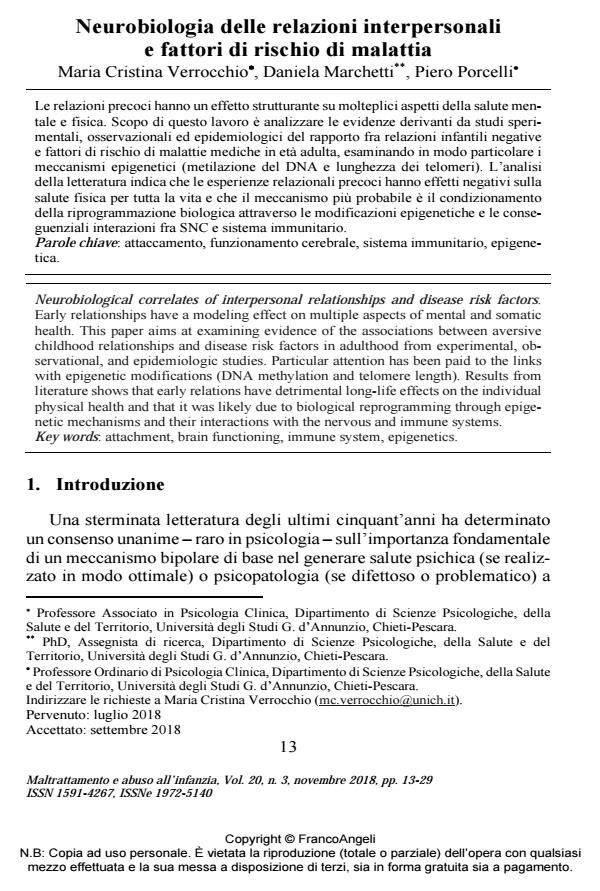Neurobiological correlates of interpersonal relationships and disease risk factors
Journal title MALTRATTAMENTO E ABUSO ALL’INFANZIA
Author/s Maria Cristina Verrocchio, Daniela Marchetti, Piero Porcelli
Publishing Year 2018 Issue 2018/3
Language Italian Pages 18 P. 13-30 File size 245 KB
DOI 10.3280/MAL2018-003002
DOI is like a bar code for intellectual property: to have more infomation
click here
Below, you can see the article first page
If you want to buy this article in PDF format, you can do it, following the instructions to buy download credits

FrancoAngeli is member of Publishers International Linking Association, Inc (PILA), a not-for-profit association which run the CrossRef service enabling links to and from online scholarly content.
Early relationships have a modeling effect on multiple aspects of mental and somatic health. This paper aims at examining evidence of the associations between aversive childhood relationships and disease risk factors in adulthood from experimental, observational, and epidemiologic studies. Particular attention has been paid to the links with epigenetic modifications (DNA methylation and telomere length). Results from literature shows that early relations have detrimental long-life effects on the individual physical health and that it was likely due to biological reprogramming through epigenetic mechanisms and their interactions with the nervous and immune systems.
Keywords: Attachment, brain functioning, immune system, epigenetics.
- Fybromialgia, interoception and risk factor for emotional dysregulation: A single case pilot study Michela Balconi, Laura Angioletti, in MALTRATTAMENTO E ABUSO ALL'INFANZIA 1/2020 pp.25
DOI: 10.3280/MAL2020-001003 - The Effect of Parent Psychological Distress on Child Hyperactivity/Inattention During the COVID-19 Lockdown: Testing the Mediation of Parent Verbal Hostility and Child Emotional Symptoms Daniela Marchetti, Lilybeth Fontanesi, Serena Di Giandomenico, Cristina Mazza, Paolo Roma, Maria Cristina Verrocchio, in Frontiers in Psychology 567052/2020
DOI: 10.3389/fpsyg.2020.567052 - Problematiche psicologiche e disturbi da stress post-traumatico in studenti universitari italiani durante il primo lockdown da Covid-19 e terapia EMDR online Giulia Savarese, Daniela D’Elia, Nadia Pecoraro, Lugi Curcio, Oreste Fasano, Monica Mollo, in MALTRATTAMENTO E ABUSO ALL'INFANZIA 2/2021 pp.63
DOI: 10.3280/MAL2021-002005
Maria Cristina Verrocchio, Daniela Marchetti, Piero Porcelli, Neurobiologia delle relazioni interpersonali fattori di rischio di malattia in "MALTRATTAMENTO E ABUSO ALL’INFANZIA" 3/2018, pp 13-30, DOI: 10.3280/MAL2018-003002